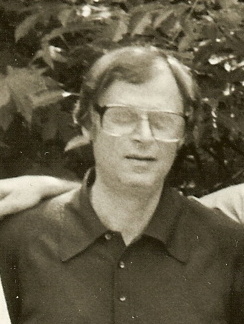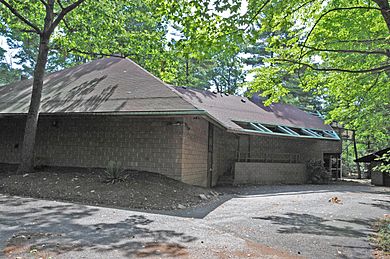Rudy Van Gelder facts for kids
Quick facts for kids
Rudy Van Gelder
|
|
|---|---|
 |
|
| Background information | |
| Born | November 2, 1924 Jersey City, New Jersey, U.S. |
| Died | August 25, 2016 (aged 91) Englewood Cliffs, New Jersey |
| Genres | Jazz |
| Occupation(s) | Audio engineer |
| Labels |
|
Rudolph Van Gelder (born November 2, 1924 – died August 25, 2016) was an American recording engineer. He was known for his work in jazz music. For over 50 years, he recorded thousands of music sessions.
He worked with many famous musicians. These included John Coltrane, Miles Davis, Thelonious Monk, and Herbie Hancock. Rudy Van Gelder recorded almost every session for Blue Note Records from 1953 to 1967. He also worked with many other record companies.
Some famous albums he worked on include John Coltrane's A Love Supreme and Miles Davis's Walkin'. He is seen as one of the most important engineers in jazz history.
Contents
Early Life and Education
Rudy Van Gelder was born in Jersey City, New Jersey. His parents, Louis and Sarah Van Gelder, owned a clothing store. From a young age, Rudy was very interested in electronics and microphones. This interest came from his love for amateur radio. He was also a big fan of jazz music. His uncle, who was also named Rudy, played drums for a band in the 1930s. Rudy Van Gelder also took lessons to play the trumpet.
He studied to become an optometrist. This is a doctor who checks eyes and prescribes glasses. He went to the Pennsylvania College of Optometry in Philadelphia. He thought it would be hard to make a living as a recording engineer. He earned his degree in 1946. After that, he worked as an optometrist in Teaneck, New Jersey until 1959.
Recording Career Begins
After his optometry work, Rudy Van Gelder spent his evenings recording local musicians. They wanted 78-rpm records of their music. From 1946, he recorded in his parents' house in Hackensack, New Jersey. He built a special control room next to the living room. The living room was where the musicians played. The way this room sounded helped create Van Gelder's unique recording style.
In 2005, Van Gelder said he started recording to make his own music sound better. He was never happy with how his records sounded. He always thought records from big companies sounded better. So, he started learning everything he could about recording.
One of Van Gelder's friends, Gil Mellé, was a saxophonist. In 1953, Gil introduced Rudy to Alfred Lion. Alfred Lion was a producer for Blue Note Records.
In the 1950s, Van Gelder also worked for a classical music label called Vox Records. In 1959, he became a full-time recording engineer. That same year, he moved his studio, the Van Gelder Studio, to a new, bigger building. This new studio was in Englewood Cliffs, New Jersey. It was built especially for recording music.
Rudy Van Gelder was very careful as an engineer. He had strict rules in his studio. No one was allowed to bring food or drinks inside. Also, no one was allowed to touch the microphones. He even wore gloves when he handled his equipment.
Later Work
Even as he got older, Rudy Van Gelder kept working as a recording engineer. In the late 1990s, he recorded some songs for the Japanese anime series Cowboy Bebop. Starting in 1999, he began to remaster his old Blue Note recordings. He turned them into new digital versions. He liked the change from older analog technology to newer digital technology.
Rudy Van Gelder lived in Englewood Cliffs until he passed away on August 25, 2016.
The Van Gelder Sound

Rudy Van Gelder was very private about how he recorded music. Fans and critics often wondered about his secret methods. He would even move microphones if people were taking pictures in the studio. His recording style is often praised for being clear, realistic, and warm.
He was one of the first to use "close miking" techniques. This means placing microphones very close to the instruments. He also used special tools to make the music sound more immediate. Van Gelder also worked hard to make sure his recordings had very little background noise. This allowed his records to be played louder.
Unlike many other engineers at the time, Van Gelder controlled almost the entire recording process. This meant he could make sure the final records sounded exactly like the original recording. Each record he worked on had his special mark: a small 'RVG' written on it.
Van Gelder helped create the famous "Blue Note sound." However, his recording style sometimes changed depending on who he worked with. Alfred Lion from Blue Note Records worked very closely with him during recording sessions.
When Van Gelder recorded for other labels, like Prestige or Savoy, he had more freedom. This allowed him to try new sound engineering techniques.
Despite his fame, some artists did not want to record with Van Gelder. The musician Charles Mingus was one of them. He felt that Van Gelder tried to change how musicians' instruments sounded. He said Van Gelder "ruined my bass sound." Even Alfred Lion, the head of Blue Note, sometimes thought Van Gelder used too much "reverb." Reverb makes sounds echo. Lion would jokingly call this a "Rudy special."
Many people say Van Gelder's way of recording the piano was very unique. It was as special as the pianists' own playing. This unique piano sound first happened because he recorded in a living room. He had to place microphones very close to the piano strings. This was to stop sounds from other instruments from mixing in. While this created a special piano sound, some critics did not like it.
Some people also criticized Van Gelder for using too much "compression." This makes loud sounds quieter and quiet sounds louder. They also said he boosted high sounds too much. Some felt this hurt the overall sound.
Writer Stanley Crouch said that Van Gelder changed the sound of John Coltrane's saxophone. He said Coltrane's real sound was darker and thicker than what was heard on the records.
His Reputation
After opening his studio, Van Gelder became very popular. Many independent record labels in New York City wanted to work with him. Bob Weinstock, who owned Prestige Records, said Rudy was a great help. He said Rudy's prices were fair, and he worked quickly. Weinstock also said Rudy's equipment was always advanced, and he was a "genius" at recording.
A JazzTimes article in 2016 said that Blue Note and Prestige Records were different. Blue Note focused on original music and had strict rules from Alfred Lion. Prestige was more relaxed, often just letting musicians play freely. Van Gelder said in 2012 that Alfred Lion was very strict about the Blue Note sound. But Bob Weinstock of Prestige was more easygoing. So, Van Gelder would try new things on Prestige recordings. He then used what he learned on the Blue Note sessions. He also worked for Savoy Records and other labels. To fit everyone in, he gave different labels different days of the week to record.
Writer Fred Kaplan said that Blue Note Records helped Van Gelder become famous. They often mentioned his name on their album covers.
Kaplan noted that other great jazz engineers existed. But other labels did not promote their engineers as much. Alfred Lion, the owner of Blue Note, made Van Gelder's sound seem special. Other labels then hired him, wanting to have that "special sauce" too.
Awards and Honors
- In 2013, Rudy Van Gelder received the Gold Medal from the Audio Engineering Society.
- In 2009, he was named a Jazz Master by the National Endowment for the Arts.
- In 2012, he received the Grammy Trustees Award.
See also
 In Spanish: Rudy Van Gelder para niños
In Spanish: Rudy Van Gelder para niños
- Category:Albums recorded at Van Gelder Studio

